The Red Sox, Brewers and A's are all riding high after hot starts, while the Twins and Reds see their stock plummet.
Two-time Super Bowl champion coach Bill Parcells once famously said, “You are what your record says you are.” For all his renowned accomplishments, Parcells has clearly never made his own power rankings. If he did, they were likely quite boring and predictable, for all we’d have to do is look up the league standings to get our answers.
Fans who are unsatisfied with their team’s record at present needn’t worry too much just yet. It can be difficult to reacclimate to a six-month season after last year’s 60-game mad dash, but there are a lot of baseball games yet to be played. However, if your team is outperforming expectations, then by all means buy into the hype—who knows how much longer the good times will last?
In Week 4 of Sports Illustrated’s MLB Power Rankings, we have a little more evidence to parse through than last time around. With each passing game, more data points accumulate that render our preseason assessments progressively obsolete, though they’re not totally out of the equation yet. As we head into the final week of April, read on to find out where each team stands.
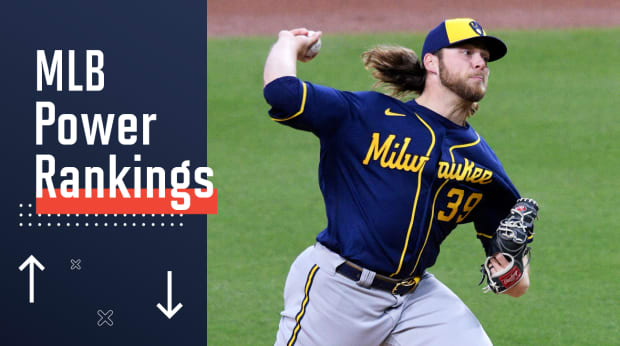
30. Detroit Tigers (Last Week: 29)
It’s been tough going for the Tigers' offense lately. Detroit has scored two runs or fewer in seven of its last eight games, and the team ranks last in batting average (.205), on-base percentage (.264), wRC+ (74) and strikeout rate (29.1%). Part of the reason is last year’s breakout star, Jeimer Candelario, has yet to hit his stride. His hard-hit rate is down to 36.8% from last year’s mark of 47.1%.
29. Texas Rangers (LW: 26)
We don’t know who’s wearing jersey No. 13 for the Rangers, but it’s certainly not the Joey Gallo that we thought we knew. From his rookie year in 2015 to 2020, Gallo posted an impressive .290 mark in isolated power, third-highest in the league during that span behind only Mike Trout (.302) and David Ortiz (.293). Through 90 plate appearances this year, Gallo is hitting .242/.444/.288, posting a .045 ISO that would make Juan Pierre blush. His average exit velocity and launch angle are both way down, though his walk rate has skyrocketed. We’re not sure how long this version of Gallo will be here for, but Rangers fans will surely welcome back their slugging savior with open arms.
28. Colorado Rockies (LW: 30)
The Rockies climb out of the basement in the power rankings, if not the NL West, after sweeping a two-game set from the Astros and taking two of three from the Phillies. Colorado unleashed a classic Coors offensive explosion in the process, averaging 6.9 runs behind three home runs from C.J. Cron, a walk-off bomb from Raimel Tapia, a grand slam from Trevor Story and Yonathan Daza’s first career homer, a go-ahead blast against Houston.
27. Baltimore Orioles (LW: 25)
For two weeks, the runaway freight train that is the Oakland A’s tore through the rest of the league with ease. Only one man could stand in their way, and that man was John Means. Just three A’s hitters put the ball in play with an exit velocity over 90 miles per hour on Sunday, with Means pitching into the seventh inning for the second consecutive outing in an 8–1 Orioles win. If you’re tired of reading about Means in this space, we don’t blame you, but we’re sure opposing batters are even more sick of seeing him.
26. Washington Nationals (LW: 23)
Only the Mets have scored fewer runs per game than Washington, who’ve won three of five since Juan Soto (strained shoulder) went on the injured list but have yet to win more than two games in a row. Patrick Corbin, who reportedly was mentioned in trade discussions this offseason, has allowed more than two base runners and one run per inning through four starts. What could the Nationals possibly get back in a deal for a player who hasn’t consistently looked his best since 2019 and is in the third year of a six-year, $140 million contract?
25. Pittsburgh Pirates (LW: 27)
The Pirates are back at .500. They’ve won or tied five straight series after starting 1–5, including wins over the Brewers, Cubs and Twins. Pittsburgh can thank its bullpen, a top-10 unit that’s helped cover for the lack of depth in the rotation, where three starters have ERAs over 6.00.
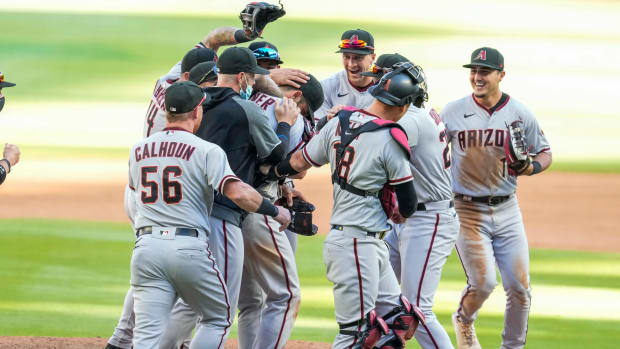
24. Arizona Diamondbacks (LW: 28)
Zac Gallen and Madison Bumgarner looked like a vicious one-two punch Sunday while combining to allow just one hit over 14 innings in Sunday’s doubleheader sweep over Atlanta, a welcome sight for a team with the NL’s worst ERA (5.19) even after that historic feat. Bumgarner’s battery mate for his "no-hitter," Carson Kelly, may be a star in the making and has helped prop up the NL’s second-highest scoring offense.
23. Miami Marlins (LW: 22)
In similar fashion to the Rockies, Miami’s young rotation has mostly held up its end of the bargain thus far—Sandy Alcantara, Pablo López and Trevor Rogers all possess ERAs below 3.50—but it hasn’t been enough to overcome a lagging lineup and bullpen. Rogers, a 23-year-old lefty with 31 strikeouts and a 1.64 ERA in 22 innings, has been especially impressive after averaging just four innings of work in seven starts (6.11 ERA) last season.
22. Chicago Cubs (LW: 24)
Chicago’s strategy of stockpiling low-velocity command artists this offseason hasn’t panned out. Cubs starters rank 26th with a 5.01 ERA, as Jake Arrieta has been the only bright spot in the rotation. The pitching staff has also logged MLB’s worst walk rate (4.7 BB/9), so even that aspect of the against-the-grain gamble has failed spectacularly.
21. Cleveland (LW: 13)
It doesn’t reflect well on Cleveland’s rotation that the group ranks 24th in fWAR despite employing reigning Cy Young Award winner Shane Bieber. The trio of Zach Plesac, Triston McKenzie and Logan Allen has been shaky, and all three have failed to consistently pitch deep into games. Cleveland’s bullpen owns the fourth-best ERA (2.77) in the majors, though an overreliance on that group could present some long-term issues.
20. Cincinnati Reds (LW: 10)
Seven straight losses, none of them by more than three runs, means Cincinnati suffers this week’s biggest drop. A large chunk of the blame has to go to the bullpen. Prominent relievers Amir Garrett (13.50 ERA in seven games), Lucas Sims (6.43 ERA in six games) and Sean Doolittle (5.19 ERA in 10 games) have all blown a save to destabilize the end game and keep the NL’s highest-scoring offense working overtime.
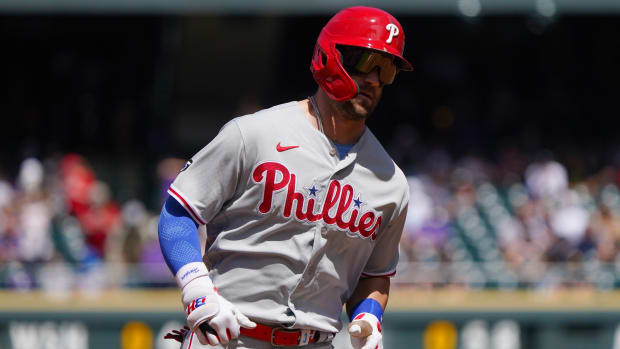
19. Philadelphia Phillies (LW: 17)
Series losses to the Giants and Rockies hurt, especially with closer Héctor Neris suffering his second loss of the season in Colorado via a walk-off homer. At least Aaron Nola (2.84 ERA, 2.46 FIP) appears to be all the way back and Bryce Harper is off to one of his patented fast starts, leading the National League in barrels rate (14.1%) and ranking second in OPS (1.132) behind only Ronald Acuña Jr.
18. St. Louis Cardinals (LW: 18)
The Cardinals haven’t allowed more than five runs since April 16 as the rotation has gotten back on track after a rough first few turns. St. Louis’s offense, thought to be a weakness coming into the season, has scored at a top-five rate in the NL and made Jack Flaherty the only pitcher to receive at least five runs of support in all five of his starts, per MLB.com. The Cardinals have just played three games against winning teams, however, tied with Atlanta for the fewest in the league.
17. Tampa Bay Rays (LW: 15)
The past year has kind of distorted how we perceive time, but it was only two years ago that Austin Meadows looked like a budding star. In 2019, Meadows’s age-24 season, he hit .291/.364/.558 with 33 home runs and 12 stolen bases, making the All-Star team and finishing 14th in MVP voting. Health was a big factor in his down 2020 season, but he looks like his old self to start 2021. He’s walking at a career-best 15.6% clip while regaining the power that made him such a force in 2019.
16. San Francisco Giants (LW: 20)
San Francisco’s rotation has quietly been the third-best in the majors by ERA (2.39), as five of six Giants to make multiple starts have registered ERAs below 2.15. Anthony DeSclafani, Aaron Sanchez and Alex Wood have all fit in seamlessly. To stay ahead of San Diego in the NL West, however, the Giants will need more hitters to step up on offense alongside rejuvenated veterans Buster Posey and Evan Longoria.
15. Toronto Blue Jays (LW: 12)
Before the season started, we loved Toronto’s lineup but had questions about its pitching. So it’s fitting that, through 21 games, the Blue Jays rank third in team ERA (3.04) and 24th in wRC+ (87). We’re a little dubious that the pitching can be this strong long term—the staff’s FIP (3.84) and xFIP (3.99) suggest regression to the mean is in store—but it’s certainly been an encouraging start, particularly given all the injuries the starting rotation has had to endure.
14. Minnesota Twins (LW: 7)
Time for a serious talk, Twins fans: your team is off to its worst 20-game start since 2016, when it finished with the worst record in baseball (59–103). Are the 2021 Twins that bad? Certainly not. Minnesota ranks 11th in wRC+ (100) and 16th in ERA (4.20)—disappointing given preseason expectations, but not as bad as its record indicates. New closer Alex Colomé has three blown saves on the young season and could be in danger of losing his job to Taylor Rogers, who has yet to allow an earned run in seven appearances.
13. Seattle Mariners (LW: 19)
Going .500 against the Dodgers and Red Sox counts as a good week in our book, which is why Seattle slides up to the top half in this week’s rankings. A key to the Mariners’ success so far has been a stellar bullpen, which owns the third-best ERA in the league (2.42). Kendall Graveman has been a true diamond in the rough here. After undergoing Tommy John surgery in 2018, he spent 2019 in the minors with the Cubs, then signed with Seattle in December 2019. Graveman struggled in 11 appearances last year but is averaging 96.5 miles per hour on his sinker to great results in 2021.
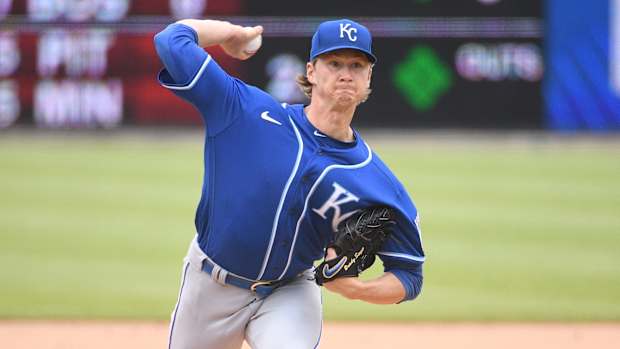
12. Kansas City Royals (LW: 14)
The Danny Duffy renaissance has truly been something to behold—he tossed five scoreless innings in Detroit on Sunday to lower his season ERA to 0.39. But the real head turner in the rotation has been Brady Singer. The former first-round pick has allowed just two earned runs over his last three starts, with 20 strikeouts in 18 innings. Opposing hitters are batting .171 against Singer’s bowling ball sinker, and the 24-year-old is generating ground balls at a 53.6% clip. To top it all off, the Royals are off to their best 20-game start since 2015. Did anything else exciting happen that year?
11. Los Angeles Angels (LW: 8)
The Angels rank dead last in team ERA (5.22), though there’s a sliver of a silver lining in the peripheral numbers if you squint hard enough. The team’s FIP (3.75) and xFIP (3.70) suggest there’s been some bad luck involved, and the Angels have allowed the highest BABIP (.323) and lowest strand rate (63.5%) in the majors. Those numbers are likely to decrease going forward due to natural regression—unless, of course, the Angels are actually doomed to keep living the same disappointment, year after year, in some sort of sick Groundhog Day–style curse (can't be ruled out yet).
10. Atlanta Braves (LW: 6)
Atlanta’s lefthanders haven’t been getting the job done. Starters Drew Smyly (7.20 ERA) and Max Fried (11.45 ERA) have been the weak spots in the rotation, while closer Will Smith (0–2, 4.00 ERA) and A.J. Minter (two blown saves, 4.82 ERA) have been shaky coming out of the pen. Atlanta also continues to struggle on offense despite ranking near the top of the Statcast leaderboards in hard-hit rate and exit velocity, with Sunday’s out-of-nowhere no-hitter from Madison Bumgarner functioning as the nadir.
9. New York Yankees (LW: 9)
Ten days ago, Yankees fans were so displeased with their team they were throwing baseballs onto the field in some kind of act of defiance. And now, everything seems ... fine? The team went 4–2 last week against Cleveland and Atlanta, with the pitching staff leading the charge. After looking somewhat mortal last year, Aroldis Chapman is back to being unhittable. His fastball is averaging 98.8 miles per hour—his fastest since 2017—and he’s struck out 17 of the 26 batters he’s faced so far.
8. Oakland Athletics (LW: 21)
All right, A’s fans—we’re sorry. We ranked the A’s 23rd on April 9 after their abysmal start, then watched them rip off eight consecutive wins to bump them all the way up to ... 21st?! In hindsight, maybe a more significant bump was in order, but Oakland’s recently halted 13-game win streak vaunts the A’s into the top 10. Among the unsung heroes through the season’s first month is lefthander Cole Irvin. The 27-year-old was an unheralded prospect and put up a 6.75 ERA with the Phillies from 2019–20 before getting traded to Oakland in January. Irvin has a 3.86 ERA and 3.57 FIP through four starts so far, walking just three batters in 21 innings.
7. New York Mets (LW: 4)
It’s not just a Jacob deGrom phenomenon anymore; New York’s offense isn’t scoring runs for anyone. The Mets are averaging less than three runs per game, and have only topped four runs in three of 17 games. The underlying Statcast metrics (eighth in exit velocity, third in expected batting average) suggest somewhat of an awakening is in the offing, however.
6. Houston Astros (LW: 5)
A lot of Houston’s usual suspects had down years in 2020, but perhaps none more so than Yuli Gurriel. He hit a meager .232/.274/.384 in 57 games after setting career highs in nearly every category in 2019. Gurriel’s been outstanding to start the year, flashing some newfound patience and control of the strike zone. He’s walking 17.6% of the time compared with a 12.1% strikeout rate, incredible considering his previous high in walk rate was 6.0%. The Astros haven’t missed George Springer much yet, as the team ranks third in the majors in wRC+ (116).
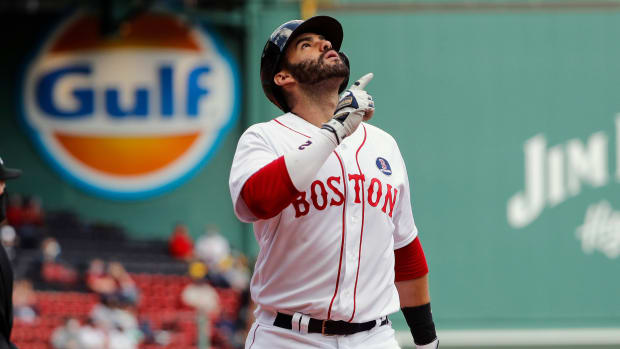
5. Boston Red Sox (LW: 11)
Behold the fiercest lineup in all of baseball. Boston is hitting an absurd .276/.340/.455 as a team, and leading the charge is one Julio Daniel Martinez. Martinez’s woeful 2020 might have made some forget just how dangerous of a hitter he is (the man won not one but two Silver Sluggers in 2018, after all). Martinez is tied for the league lead in home runs, matching his 2020 total in just over one-third of the plate appearances. Given his track record, last season’s hiccup is looking more like the exception rather than the new rule, lending more credence to Boston’s 2021 playoff hopes.
4. Milwaukee Brewers (LW: 16)
The Brewers swept the Padres in San Diego before taking two of three from the Cubs at Wrigley Field over the weekend, and have accordingly leapt up the rankings as one of a select few teams outside of Southern California to display the potential for outright dominance. Milwaukee’s starters have more than compensated for an offense far too reliant on catcher Omar Narváez (.389/.477/.574). Corbin Burnes, Brandon Woodruff and Freddy Peralta—who’s been so nasty that has league-high walk rate hasn’t bit him too much—make up the top half of the rotation no one wants to face in October.
3. Chicago White Sox (LW: 3)
With the understanding that hitters change their approach depending on the count or general game situation, I can say with a good amount of confidence that I’ve never seen a hitter with a greater discrepancy in their front foot load than Yermin Mercedes. Exhibit A from Saturday:
And here’s from Friday’s game:
Granted, the second swing in which Mercedes’s left foot doesn’t leave the ground came on a two-strike count. Still, it’s quite the juxtaposition, and it’s impossible to argue with the results. Mercedes is hitting .411/.461/.657 through 19 games—not bad for a 28-year-old rookie.
2. San Diego Padres (LW: 2)
San Diego leads MLB in stolen bases (31) by nine bags after becoming the first team since the 2013 Rangers to steal five bases on back-to-back nights in this weekend’s thrilling four-game set against Los Angeles. Entering Sunday night, teams trailing by six or more runs in the seventh inning or later were 100–13,547. That’s a 0.7% chance of winning for the average team. But the Padres aren’t an average team, and they were able to come back and win in extra innings against the best team in baseball.
1. Los Angeles Dodgers (LW: 1)
It had been nearly a decade since the Dodgers’ last loss after leading by at least six runs in the seventh: Aug. 10, 2011, against the Phillies. Sunday’s collapse resulted in Los Angeles’s first four-game series loss since Aug. 29 to Sept. 1, 2019, and ensures the Dodgers will be counting down the days until their next game against the Padres on June 21—just like the rest of us.
More MLB Coverage: